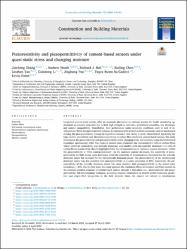| dc.contributor.author | Zhang, Jiacheng | |
| dc.contributor.author | Heath, Andrew | |
| dc.contributor.author | Ball, Richard J. | |
| dc.contributor.author | Chen, Binling | |
| dc.contributor.author | Tan, Linzhen | |
| dc.contributor.author | Li, Guisheng | |
| dc.contributor.author | Pan, Jingbang | |
| dc.contributor.author | Su-Cadirci, Tugce Busra | |
| dc.contributor.author | Paine, Kevin | |
| dc.date.accessioned | 2024-08-29T12:21:34Z | |
| dc.date.available | 2024-08-29T12:21:34Z | |
| dc.date.issued | 2024 | en_US |
| dc.identifier.issn | 09500618 | |
| dc.identifier.uri | https://doi.org/10.1016/j.conbuildmat.2024.136052 | |
| dc.identifier.uri | https://hdl.handle.net/20.500.12573/2363 | |
| dc.description.abstract | Integrated cement-based sensors offer an economic alternative to extrinsic sensors for health monitoring applications in concrete structures due to their high strength to cost ratio, geometrical versatility, low shrinkage, and natural compatibility. Nonetheless, their performance under in-service conditions were in lack of investigations. While the piezoresistivity (change in resistance with stress) has been commonly used for mechanical sensing, the piezopermittivity (change in capacitive reactance with stress) is rarely characterized. Exploiting the high relative permittivity and electrical conductivity of carbon fibre reinforced cement-based sensors, this study investigates the piezoresistivity and piezopermittivity under changing stress and moisture using electrochemical impedance spectroscopy (EIS). Two types of sensors were evaluated: one containing 0.5 vol% of carbon fibres whose electrical conductivity was ionically dominant, and another with electronically dominant (1.2 vol% of carbon fibres) conductivity. Results highlighted that the piezopermittivity is “moisture content-dominant” whilst the piezoresistivity is “fibre content-dominant”. As the moisture content decreased, the sensitivity of piezopermittivity for both sensor types decreased, while the sensitivity of piezoresistivity decreased for the ionically dominant sensor but increased for the electronically dominant sensor. The piezoresistivity of the electronically dominant sensor was less sensitive than piezopermittivity at a water saturation of 80%. Conversely, the piezoresistivity of the ionically dominant sensor was more sensitive than piezopermittivity at the tested water saturations ≤ 80%. For the first time, this study presents the combined effects of moisture and fibre content on the pressure sensitive response of cement-based sensors through a dual-phase (i.e., piezoresistivity and piezopermittivity) EIS interpretation technique, providing valuable information to benefit further behaviour prediction and single-effect recognition in the field scenario where the sensors are subject to simultaneous environmental effects causing moisture variations such as temperature and humidity variations, freeze-thawing, and so on. | en_US |
| dc.description.sponsorship | The authors gratefully acknowledge the technical staff at the University of Bristol and within the Department of Architecture & Civil
Engineering at the University of Bath for the technical support & assistance in this work. The Engineering and Physical Sciences Research Council (EPSRC) is thanked for funding the Resilient Materials for Life (RM4L) project (grant ID: EP/P02081X/1). The authors thank Professor Benny Suryanto at the Heriot-Watt University and Professor Antony Darby in the Department of
Architecture & Civil Engineering at the University of Bath for their valuable suggestions on the paper. | en_US |
| dc.language.iso | eng | en_US |
| dc.publisher | Elsevier Ltd | en_US |
| dc.relation.isversionof | 10.1016/j.conbuildmat.2024.136052 | en_US |
| dc.rights | info:eu-repo/semantics/openAccess | en_US |
| dc.subject | Carbon fibers | en_US |
| dc.subject | Self-sensing cement-based sensor | en_US |
| dc.subject | Electrochemical impedance spectroscopy | en_US |
| dc.subject | Piezoresistivity | en_US |
| dc.subject | Piezopermittivity | en_US |
| dc.subject | Moisture content | en_US |
| dc.title | Piezoresistivity and piezopermittivity of cement-based sensors under quasi-static stress and changing moisture | en_US |
| dc.type | article | en_US |
| dc.contributor.department | AGÜ, Mimarlık Fakültesi, Mimarlık Bölümü | en_US |
| dc.contributor.authorID | 0000-0001-6617-0924 | en_US |
| dc.contributor.institutionauthor | Su-Cadirci, Tugce Busra | |
| dc.identifier.volume | 425 | en_US |
| dc.identifier.startpage | 1 | en_US |
| dc.identifier.endpage | 20 | en_US |
| dc.relation.journal | Construction and Building Materials | en_US |
| dc.relation.publicationcategory | Makale - Uluslararası Hakemli Dergi - Kurum Öğretim Elemanı | en_US |


















